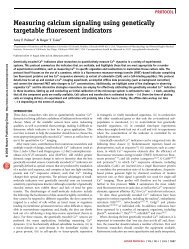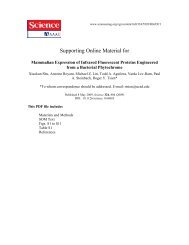THE GREEN FLUORESCENT PROTEIN - Tsien
THE GREEN FLUORESCENT PROTEIN - Tsien
THE GREEN FLUORESCENT PROTEIN - Tsien
You also want an ePaper? Increase the reach of your titles
YUMPU automatically turns print PDFs into web optimized ePapers that Google loves.
538 TSIENAdvantages and disadvantages of FRET between (GFPs) to monitor protein inter-Table 4actions.AdvantagesWorks in vitro and in living mammalian cells, not just yeastCan respond dynamically to posttranslational modificationsHas high temporal (milliseconds) and spatial (submicron) resolutionInteracting proteins can be anywhere in the cell and do not need to be sent to nucleusDegree of association can be quantified, if 0% and 100% binding can be established in situEfficiency of FRET at 100% complexation gives some structural informationDisadvantages of intermolecular FRETMust express fusion proteins, in which host protein and GFPs must both remain functionalIf GFPs are too far from each other (≫80 Å) or unluckily oriented, FRET will failEven with no association, spectral overlap contributes some signal at the FRET wavelengthsTrace or rare interactions will be hard to detectNeed negative and positive controls, i.e. reference conditions of 0% and 100% associationHomodimerization is more difficult to monitor than heterodimerizationis best used at a later stage when the two host proteins are molecularly wellcharacterized and the detailed spatiotemporal dynamics of their interaction isto be determined in live cells.What Are the Best FRET Partners?The efficiency of FRET is given by the expression R 6 0 /(R6 0 + r 6 ), where r is theactual distance between the centers of the chromophores and R 0 is the distanceat which FRET is 50% efficient. R 0 depends on the quantum yield of the donor,the extinction coefficient of the acceptor, the overlap of the donor emission andacceptor excitation spectra, and the mutual orientation of the chromophores(102). The early attempts to obtain FRET between GFPs all used BFPs (class6 mutants) as donors and class 2 (phenolate anion) GFPs as acceptors becausethese were the first available pairs with sufficiently distinct wavelengths. Forsuch pairs, R 0 is calculated to range from 40 to 43 Å. However, the poorextinction coefficients, quantum yields, and photostabilities of the BFPs haveconvinced us (50) that cyan mutants (class 5) are much better donors. Theacceptor correspondingly must become a class 4 yellow mutant so that itsexcitation spectrum overlaps the donor emission as much as possible, whereasthe two emissions remain as distinct as possible. Combinations of cyan donorswith yellow acceptors have R 0 values of 49–52 Å and are our currently preferreddonor-acceptor pairs. So far, the highest value of R 0 between two GFPs is 60 Åfor class 3 mutant H9-40 as donor to Topaz, but unfortunately these mutants’emission spectra are too close to each other for good discrimination.The above calculations have assumed that the GFPs are randomly orientedor tumbling with respect to one another, which is the conventional assumption






